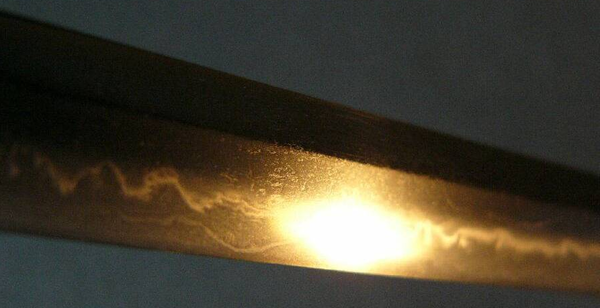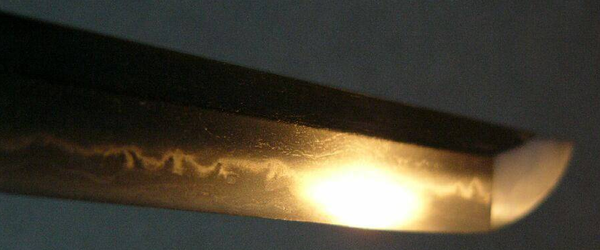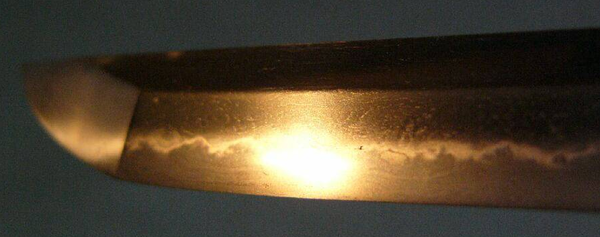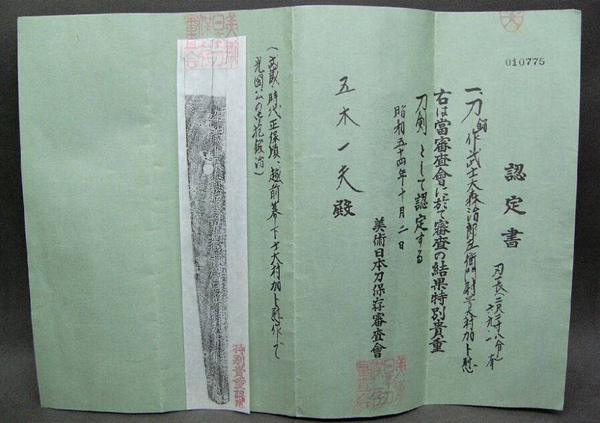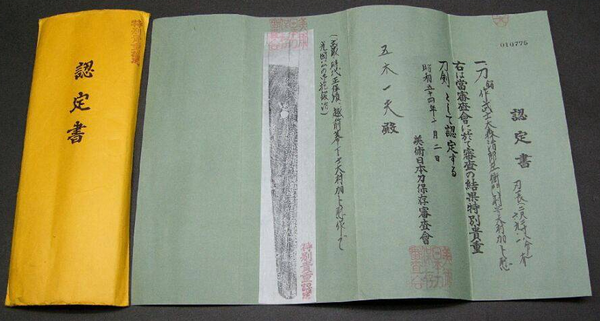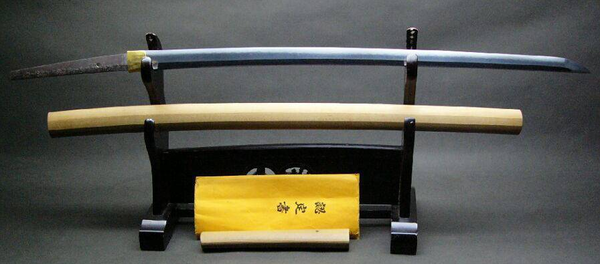-
Posts
120 -
Joined
-
Last visited
-
Days Won
1
Content Type
Profiles
Forums
Events
Store
Downloads
Gallery
Everything posted by general_piffle
-
Hi Mark, can I ask what led you to this thought? I asked Aoi Art and Tsuruta san said he believed the horimono had been put in at the time the sword was made. Because the smith Yoshikado was training under Omura Kaboku who was also a buddhist monk. And as SteveM has observed both the kurikara and sanko are buddhist motifs.
-
Yes Klaus, high5japan is having another go at auctioning it. I have seen him auction some decent enough swords with recent NBTHK papers but this one really isn't listed accurately and his approach to customer service was dreadful - borderline deceitful. Even after I'd returned the sword and it had been signed for (I could see from the delivery tracking) I had to wait days to get a reply from him. When he did reply he said that the mekugi peg had been crushed, insinuated this was my fault, and that it meant the tsuka was stuck. He said he was going to take the sword to an expert to get the tsuka removed and he would take this cost out of my refund. Bearing in mind he also refused to pay return postage for an item that was inaccurately listed I was shocked at his attitude. Fortunately it was only due to the fact that in opening the return with eBay I'd taken detailed pictures of the tsuka including the big gaps between tsuba and seppa that I was able to challenge him. As one of my pictures clearly showed the crushed / split mekugi peg had been there when the sword was delivered to me. Once I pointed this out to him and spent a good deal of time on the phone to eBay he finally conceded and gave me a full refund. But talk about disingenuous. Hence my warning to others where high5japan is concerned.
-
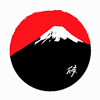
Had To Share This Beautiful (To My Eyes) Tsuba
general_piffle replied to general_piffle's topic in Tosogu
It's a beauty isn't it. If I had the surplus I'd be sorely tempted. -

Had To Share This Beautiful (To My Eyes) Tsuba
general_piffle replied to general_piffle's topic in Tosogu
Glad you like it! Not wakizashi but katana. -
-
Having seen a couple of antique katanas recently with engravings of dragons on the blade, I'm curious to understand the background to decorating the blade of a nihonto. Did these decorations mean the sword was purely for ornamental / decorative purposes? Would a decorated sword actually be used in battle? Was there a reason behind say a dragon decoration other than aesthetic - like imbuing the sword with a good luck blessing or the strength of a dragon for example? Would love to find out more behind this practice. Many thanks. Joel U.
-
If you're new to the world of nihonto be aware of the eBay seller high5japan. I can only give my personal experience as reference but it was by no means a good experience. At around the same time as finding this forum I also found a sword on eBay that I liked the look of being sold by high5japan. He listed it as the saya being a bit loose at the mouth. I asked a few questions and was satisfied with his answers that it would be a simple fix. So I bid and won. When the sword arrived it was actually the tsuba, seppa, and tsuka that were loose. Very loose. As they were clearly never intended to go with that sword. The tsuba and seppa rattled around on the nakago with a good half inch of play. They literally jangled whenever the sword was moved. I got a refund through eBay's rules by opening a case but it was a difficult return that the seller made as protracted as possible - not replying to messages, delaying tactics, just really poor customer service (if any). The sword was then put up for sale again. I watched it out of curiosity and a few weeks ago it sold for around the same price that I'd originally paid for it. This evening I noticed it's up for sale again, so I imagine the buyer after me also returned it. But it's up for sale now at three times the price it sold for at auction: http://www.ebay.co.uk/itm/272074361245 So if you are thinking about buying from this seller I'd advise you to be very careful.
-
Just a quick update. Komonjo has been an absolute gentleman and all-round great guy to deal with. He refunded my import tax and return postage without me even having to ask him, plus kept me notified of any updates. The sword was returned to him via eBay's system and when it arrived with him today I received a full refund. Mud clearly sticks from some of the negative things people say about him here but in my experience he's been helpful and honest throughout.
-

Brainstorming: Gendai Project Online
general_piffle replied to Markus's topic in General Nihonto Related Discussion
Good idea Markus, here are some random 'starter for 10' thoughts. How about a wiki element but templated and with admin so you can share the work load and add to the knowledge pool? With the book angle why not keep it time-based so maybe annual updates. Or if the paper book took more of a folder / binder approach it would be easier to add updates when needed. I've worked in digital media, including big site builds and content creation, for many years. If I can offer any advice then please feel free to PM me. Thanks. -

New Member Introductions
general_piffle replied to Dusty62's topic in General Nihonto Related Discussion
Good evening all, having joined recently I thought I should introduce myself here. I'm a creative writer for advertising by profession but studied fine art at Chelsea School of Art many years ago. My specialisation (outside of art history) was sculpture, including ancient traditional techniques such as 'lost wax' metal casting. I also do volunteer work in a legal capacity. I've been fortunate to travel to and spend time in Japan, including Tokyo, Nara, Kyoto and Sendai. I've had a fascination with Japanese culture and crafts for many years but have only recently considered actually purchasing a proper nihonto. Peace and good health to you all. -
Thanks for your concern Ian, it's much appreciated. Personally I don't believe anyone deserves to be ripped off but each to their own. The return was accepted without a quibble and has been logged with eBay so under their rules and those of PayPal I'm covered. Having been buying and selling on eBay since 2008 I've yet to have a problem with a return.
-
Gentlemen, just to add I have had word from Chris of www.ejapaneseswords.com who has confirmed that the NBTHK certificate is nothing of the sort. This is part of what he said, and I've attached the pictures he's referring to: "Yours is dated Showa 54 (1979) and the issuing organization is the Bijutsu Nihonto Hozon Shinsa Kai 美術日本刀保存審査会. This is not the NBTHK. I have never heard of them. Here is a genuine Showa 49 NBTHK kantei-sho. Note column 8 where it says 日本美術刀剣保存協会. They were issues up until Showa 57 (1982). Obviously they are similar in appearance but different." This could be useful as future reference for anyone else looking for info. Thanks.
-
Good idea Brian, thanks. However, it has just shipped yesterday. On top of that I now have a choice because I requested a return from the seller who has granted it with no quibble at all. He simply told me that as the package has shipped I can refuse it or return it when it arrives, as I logged it with eBay as a return I'm covered (personally as a buyer on eBay I've yet to have a bad experience with returns) so I'm confident I'll get my money back. With buying from eBay I was under the impression that this was a 'no no' if the sword wasn't papered, so with respect I thought I was following advice here and 'doing the right thing' by choosing a papered sword. I can appreciate many of you guys probably feel you've seen it and heard it all before but we all start somewhere and just because we're new it doesn't make us stupid. Although I'm sure this was unintentional some of the feedback has come across as pretty negative. However, to add another consideration into all this I didn't originally purchase the sword because of who it was made by. So the smith and mei were secondary to what I believed (with my untrained eye) to be a good-looking nihonto with really interesting hamon (to me) and no obvious rust or blemishes. It was only after I started looking into the smith and stumbled across the excellent article from Thomas (Toryu) that started this thread that I became really fascinated by Omura Kaboku. I've been in discussion via PM with a few very helpful people far more knowledgeable than me who have all offered contrasting views. Bottom line (and all have agreed on this) is nobody can currently, definitively, say whether the mei is genuine or not. But can I ask is Omura Kaboku someone who gets faked a lot? I'm probably wrong but I didn't think he was one of the greats, more well known for his eccentricities than creating incredibly valuable swords that would be worth faking? But like I said, the more I discover the less I know. So, I'm now left with a number of choices. I return the sword, get my money back and treat this as a learning experience. I keep the sword, consider it to possibly be a Kaboku and take the 'all old papers are fake' with a pinch of salt, and treat this as a learning experience. I keep the sword, put it forward for shinsa to see what the experts have to say with it in their hands, and treat this as a learning experience. Decisions, decisions! But thank you all for your advice and inputs, both the positive and the negative. It's all good
-
Thanks very much for the positive attitude Derek! As a newcomer to the board it's really appreciated. So from reading through the thread in the link you provided a lot of people are saying that while there has been some discredit of the accuracy of NBTHK certification from a certain time and in more provincial areas it's also a problem that isn't as prolific as some are making out. That part, when it comes to the internet generally, is of no surprise. Bottom line for me is of course I hope it's original and I might well send it to shinsa through our very own Kunitaro san out of curiosity. But regardless, in my eyes it's a beautiful sword that has 'probably' come from a fascinating sword-smith - and that's enough for me
-
Hi Markus, couple of things. When I found the information through Google I had no idea that it had been provided by someone on this forum. When Toryu / Thomas replied to this thread I recognised the URL in his signature and figured out where it had come from. Have a look at my post immediately after Thomas's where I thank him, saying "Thank you for having provided so much interesting information about him". Is there some kind of protocol where I should now edit my original post to accredit Toryu with the benefit of hindsight or is acknowledging him and saying thanks enough?! Not being sarcastic just becoming more aware of the 'idiosyncracies' of this message board... Thanks.
-
Stephen, thank you for the advice. I'm going to take you up on it. Let's face it, the sword has been around for several hundred years and isn't going anywhere. I'll use it to learn from and enjoy before thinking about a polish again later. But am so happy to have this. It looks to my untrained eye to be a beauty and from such a wonderfully eccentric sword-smith
-
I really wouldn't have any idea. Perhaps you could enlighten me? What a fascinating character Omura Kaboku was. Someone who certainly did things their own way. I'm so proud to have one of his swords and will certainly look after it with respect. Thank you for having provided so much interesting information about him. I'm intrigued to find out more!
-
I found the following fascinating and hope you also enjoy it. Having just bought a katana made by Omura Kaboku I thought it best to research him. The more I discovered the more I liked him... Omura Kaboku. Born in Suruga Uegahara the 2nd son of Mori Sukeemon officially he was Shintaro then Jirozaemon then Goroemon and finally Jibuzaemon. Early signatures include 義博Yoshihiro, 義秀Yoshihide and 康英Yasuhide. He studied medicine under Tsunoda Kyuho, and he seems to have started forging swords at an early age. According to legend because he had taken up the study of western medicine and he was not satisfied with the scalpels that were available, so endeavoured to make his own. He was employed as the On-Geka, Lords Surgeon, for the Echigo Takata Matsudaira family serving Mitsunaga, here forged many swords and seems to have had access to the family’s swords. There was a dispute over the succession of this household that finally reached the ears of the Shogun. All were punished according to rank, several of the lords counsellors were ordered to commit seppuku and this branch of the Matsudaira family was abolished. When the time came he walked with his lords procession, as it headed back to Echigo, to the outskirts of Edo, where he knelt beside the kago and asked to be relieved of duty. With his princes’ blessing he now stood beside the roadway, the procession disappearing in the distance, a ronin. At this same time in Edo, Zhu Shunsui a minister of the Ming government was living in exile, working to restore his own government and return to China. He was known as a great scholar and this attracted many learned men to his door. Kaboku is known to have visited him, perhaps he was researching a question of medicine or of ancient literature or perhaps he himself sought to restore his own lord and found in him a kindred spirit. Whatever the circumstance both men soon found themselves in the employ of Mito Komon Mitsukuni. Zhu Shunsui as a scholar working on the Dai Nihon Shi and Kaboku as physician, companion and swordsmith. Now we mentioned that Kaboku was a singular individual, Fukunaga Suiken calls him a first rate eccentric, the tops among swordsmiths. He was an adept at Jujutsu, he studied western medicine, Chinese medicine, as well as the forging techniques of many of the great koto swordsmiths. He must have been very well educated to appeal to Mitsukuni and to be included in his rare group of scholarly friends and advisors. He was a fanatic believer in Shingon sect Buddhism and was by many accounts very much convinced of his own superiority. Add to this the tale that he was enamoured of sleeping in the nude and was known to relieve himself in public in this state. It has been said that he protested the noisy passers-by in his neighbourhood of an early morning, by defecating in the street, in full view. Of course if anyone complained they found he was personal physician to the lord of Mito and the complaints stopped there. It is not clear where he learned sword-making, though some sources suggest it was with Hojoji Saburodayu Masahiro. He made katana and wakizashi in Bizen or Soshu style, itame hada tachi with masame in the shinogi ji. He liked to copy the Dojigiri Yasutsuna a blade which he said he saw often, perhaps during his time in Echigo. The Kantei Dokuhon describes the works as rustic but I personally found the Kaboku blade at the 1997 national Museum exhibit to be one of the more interesting pieces. It had outstanding hada, visible utsuri and a finely cut hi. You’ll find it is item number 283 in the Nihon no Katana catalogue but the photos do not do it justice. His earliest dated work is from Shoho 3 nen, when he was still employed in Echigo. His signatures include: 越後幕下士大村加卜作 Echigo Bakkashi Omura Kaboku tsukuru 作武士大森治部左衛門号大村加卜慰作 saku Bushi Omori Jibuzaemon go Omura Kaboku isaku 越後幕下士大村加卜慰作之 真十五枚甲伏造 Echigo Bakkashi Omura Kaboku isaku kore Shin-jugomai kobuse tsukuru 越後幕下士大村加卜慰作慰作真十五枚甲伏安綱伝 Echigo Bakkashi Omura Kaboku isaku Shin-jugomai Kobuse Yasutsuna den 越後幕下士大村加卜慰指図鍛冶欲聞 九百年来の物語子非鍛冶 Echigo Bakkashi Omura Kaboku i sashizu Tanya yoku hosuru ki kyuhaku-nen kitasu no monogatari ko hi Kaji 常陸国水戸住真珠五枚甲伏鍛大村加卜作 Hitachi (no) Kuni Mito ju Shin-jugomai Kobuse kitau Omura Kaboku saku. Other works date from Kanbun 11 and Empo 4 and 5 this is a rather long span, giving rise to the theory that there may have been a nidai though this remains unproven. If he was twenty years of age say when he debuted as a full fledged swordsmith in Shoho 3 he would have been over 80 when he finally met his end in Genroku 17. As you can see from his mei he seems to have done most of his forging while a young man in Echigo, though he is thought of as a Mito smith (Tsunaishi says Edo). He seemed to stress that he was no swordsmith at all but a samurai making swords for pleasure including the term “isaku” in many of his signatures. This is supported by the fact that Mito employed his students and his job seemed to be Physician or companion to Giko. We can surmise that he was in Edo most of his time while in the employ of Mitsukuni attending upon the lord where he in fact had to spend most of his time. We do know that he forged swords in Mito at the Kyotofuji Temple a rather out of the way spot in relation to the castle town but a Shingon temple with a large following in his time. We know that he forged here because beside the records that tell of his work there, there exits a kusari-gama that he forged for the village headman at whose home he stayed while working at the temple. He was known to be deeply devoted to his Shingon practice, one can imagine him feverishly reciting sutras as the monks burned piles of fuda, chanting along with him and his assistants Boku-O (卜翁) and Boku-yu (卜宥) as they hammered steel into blade. These two were actually the Edo Akasaka smith Shimosaka Kunihiro and the Hachioji Shitahara smith Yamamoto Fujio Yasukuni. Another of Kaboku’s students would style himself as Bando-Taro Boku-Den (卜伝). It is testament to Kaboku’s faith and personality that these men took Buddhist vows to become to his co-workers and officially took the names he bestowed upon them. Incidentally one of Tokugawa Mitsukuni’s reforms was to abolish the practice of laymen shaving their heads when they took Buddhist vows in retirement. One wonders if that policy was influenced by Kaboku in anyway. Kaboku’s works were thought of as wazamono or excellent cutting blades. As a young man it is said he himself cut off the head of an oxen with one of his own blades. This earned him the nickname of Ushikirimaru. On another occasion one of his swords is said to have split a Saotome helmet, and as testament to the fame of this event there is a gimei Kaboku blade with the name “Kabuto-wari” engraved right on the tang. Miura Okiemon Yoshimasa a master of Shin Tamiya Ryu Iaijutsu tested some of Kaboku’s blades on the executed at Mito Akanuma prison. One of his works carries the go of Gyotoku-ken or “sword of meritorious action.” There was also a ho-no-tachi or offertory sword that Kaboku dedicated to the Suwa jinja but sadly this was looted by the occupation army. This author at least is one man who would love to see it if it made it’s way to America. Since his works are rather scarce Kaboku’s greatest contribution might be considered his book Kento Hiho (劍刀秘宝) ; Secret Treasures of The Sword. There were many impressions of this book printed and it is also known as Token Kaji Hiden (刀剣鍛冶秘伝) or Secrets of the Swordsmith. He opens his work with the statement that only four swordsmiths understood the true secret of making a masterpiece; Hoki Yasutsuna, Kamakura Ichimonji Sukezane, O-Sa and himself! He came to this realization “thanks to heaven and the light of the tachi which I myself have forged!” There are some writers who say that Kaboku was not mentally disturbed at all but that pronouncements like the above were not at all welcomed by his contemporaries and that is when people started saying he was crazy. His book is a fascinating treatise on the construction and workmanship found in the great swords of old. He looks at Yasutsuna who was a favorite of his, Masamune, Sadamune, Ichimonji, Nagamitsu, Sukezane, Hosho, Hisakuni, Yoshimitsu, Yoshihiro, Norishige, Gassan, Sa, The Aoe and Mizuta schools as well as others. He focuses on the jigane and construction methods from which he “rediscovered” the secret of Shin Jugo-mai Kobuse construction. A fact he notes on his nakago and his students used the method and also note this on their nakago but just what the details are of this remain unknown. The superiority of his method is widely touted throughout his book by him of course. It is not clear what exactly his New fifteen fold method of kobuse was However his writing drew many to take a second look at the old masterpieces. Suishinshi Masahide was inspired by Kaboku’s book to do his own research and reexamine the methods of the old swordsmiths. Kaboku left the employ of the Mito family in January of 1699, Genroku 12. Some say because he did not get along with his immediate superior the Karo, Nakayama Bizen no Kami, others that his peculiar behavior and egotistical manner was offending too many people and this reached the ears of the lord. House records from 1698, record that his health was failing and it was decided that he be “retired” to Mito. Perhaps he did not wish to leave Edo and be confined to Mito. Whatever the reason the house record notes that he officially asked to resign and left to devote himself to his religious studies on that date. Five years later found him in the far north living in Oshu Nihonmatsu where one night he stood naked in his garden where he was confronted by an assassin. To this day no one knows who the man was nor why he might have been sent to kill Kaboku but his intent was clear enough. Without hesitation Kaboku, who held a mokuroku in Shibukawa-ryu Jujutsu, charged as his attacker charged him. He grabbed his left wrist with his right hand and used his own left arm to block the cut that was descending toward his head. Still clutching his severed left hand in his right he closed with his attacker and thrust the jagged bone into the mans mouth, here he fell upon him and smothered him with the bloody relic. Kaboku then went back into his home, perhaps something the assassin had said struck him, perhaps he understood from his own wounds that he would not survive, it is not clear why but using only the right hand he drew out a tanto and took his own life. A strange end for one of the sword worlds strangest characters. There is no mention of a wife or daughter in the histories but at least one says that Musashi no Kami Yoshikado became his son-in-law and took the name Bokuden.
-

How Were Tsuba, Menuki, And Fuchi Kashira Chosen?
general_piffle replied to general_piffle's topic in Nihonto
From reading the posts here and doing a bit more studying online I'm coming to the conclusion that actually - identical to today (so no surprises there) - having a theme as such was and is a personal choice. So some would have a clear theme in mind when briefing a craftsman to dress their sword and others really wouldn't be that bothered. In effect no different to today say if one of us was buying a new car and deliberating over optional extras, metallic or non-metallic paint, matching trim, etc. or simply saying "yep, I want the 2.5 manual 5 door and that's it".












